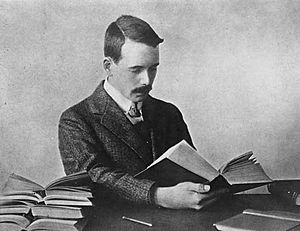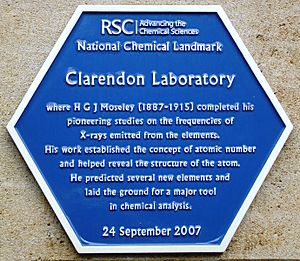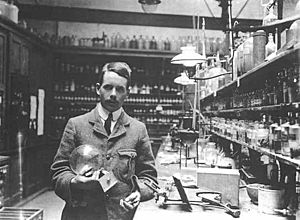Henry Moseley facts for kids
Quick facts for kids
Henry Moseley
|
|
|---|---|

Moseley in 1914
|
|
| Born |
Henry Gwyn Jeffreys Moseley
23 November 1887 |
| Died | 10 August 1915 (aged 27) |
| Cause of death | Killed in action |
| Nationality | English |
| Citizenship | British |
| Education | Summer Fields School Eton College |
| Alma mater | Trinity College, Oxford University of Manchester |
| Known for | Atomic number, Moseley's law |
| Awards | Matteucci Medal (1919) |
| Scientific career | |
| Fields | Physics, chemistry |
| Influences | Ernest Rutherford |
Henry Gwyn Jeffreys Moseley (/ˈmoʊzli/; 23 November 1887 – 10 August 1915) was an English physicist. Moseley observed and measured the X-ray spectra of various chemical elements and formulated what later became known as Moseley's law. He discovered that there is a relationship between the wavelengths of the emitted X-rays and the atomic numbers of elements. Before Moseley's work, "atomic number" was merely an element's place in the periodic table and was not known to be associated with any measurable physical quantity. Moseley's Law helped prove many ideas in chemistry by organizing the chemical elements of the periodic table in a logical order based on their physics.
When World War I broke out in Western Europe, Moseley left his research work at the University of Oxford behind to volunteer for the Royal Engineers of the British Army. Moseley was assigned to the force of British Empire soldiers that invaded the region of Gallipoli, Turkey, in April 1915, as a telecommunications officer. He was killed during the Battle of Gallipoli on 10 August 1915, at the age of 27.
Contents
Early life and education
Henry G. J. Moseley, known to his friends as Harry, was born in Weymouth in Dorset in 1887. His father Henry Nottidge Moseley (1844–1891) was a biologist and also a professor of anatomy and physiology at the University of Oxford. He died when Moseley was quite young. Moseley's mother was Amabel Gwyn Jeffreys, the daughter of the Welsh biologist and conchologist John Gwyn Jeffreys.
Moseley did well at Summer Fields School, and was later awarded a King's scholarship to attend Eton College. In 1906, Moseley entered Trinity College of the University of Oxford, where he earned his bachelor's degree.
Scientific work
After graduating from Oxford in 1910, Moseley became a demonstrator in physics at the University of Manchester under the supervision of Sir Ernest Rutherford. During Moseley's first year at Manchester, he had a teaching load as a graduate teaching assistant, but following that first year, he was reassigned from his teaching duties to work as a graduate research assistant.
In 1913, Moseley observed and measured the X-ray spectra of various chemical elements (mostly metals). Moseley discovered a systematic mathematical relationship between the wavelengths of the X-rays produced and the atomic numbers of the metals that were used as the targets in X-ray tubes. This has become known as Moseley's law.
Moseley's discovery demonstrated that the atomic numbers of elements have a firm experimental basis from the physics of their X-ray spectra. He postulated that each successive element has a nuclear charge exactly one unit greater than its predecessor. Moseley's work helped to sort the elements into an exact sequence of ascending atomic numbers that made the Periodic Table exact.
Death and legacy
Sometime in the first half of 1914, Moseley resigned from his position at Manchester, with plans to return to Oxford and continue his physics research there. However, World War I broke out in August 1914, and Moseley turned down this job offer to instead enlist with the Royal Engineers of the British Army. Moseley served as a technical officer in communications during the Battle of Gallipoli, in Turkey, beginning in April 1915, where he was killed by a sniper on 10 August 1915.

Only twenty-seven years old at the time of his death, Moseley could, in the opinion of some scientists, have contributed much to the knowledge of atomic structure had he survived. Isaac Asimov wrote, "In view of what he [Moseley] might still have accomplished … his death might well have been the most costly single death of the War to mankind generally."
Memorial plaques to Moseley were installed at Manchester and Eton, and a Royal Society scholarship, established by his will, had as its second recipient the physicist P. M. S. Blackett, who later became president of the Society.
Interesting facts about Henry Moseley
- Moseley's mother was the British women's champion of chess in 1913.
- Moseley showed that there were gaps in the atomic number sequence at numbers 43, 61, 72, and 75. These spaces are now known, respectively, to be the places of the radioactive synthetic elements technetium and promethium, and also the last two quite rare naturally occurring stable elements hafnium (discovered 1923) and rhenium (discovered 1925). Nothing was known about these four elements in Moseley's lifetime, not even their very existence.
- Moseley's family and friends tried to persuade him not to join the army when World War I broke out, but he thought it was his duty.
- Some scientists believe that Mosely's work would have earned him the Nobel Prize had he not been killed.
- The Institute of Physics Henry Moseley Medal and Prize is named in his honour.
See also
 In Spanish: Henry Moseley para niños
In Spanish: Henry Moseley para niños


